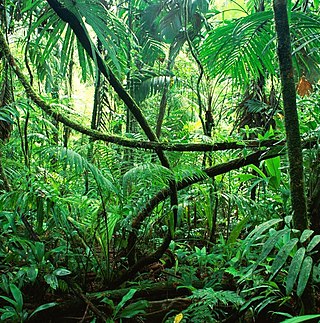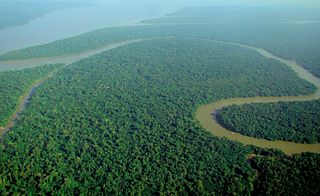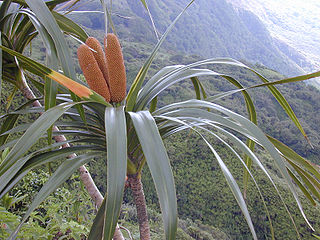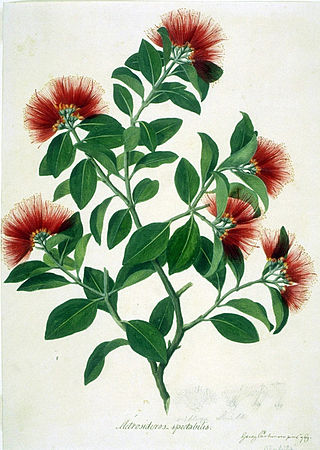
Rainforests are forests characterized by a closed and continuous tree canopy, moisture-dependent vegetation, the presence of epiphytes and lianas and the absence of wildfire. Rainforests can be generally classified as tropical rainforests or temperate rainforests, but other types have been described.

Tropical and subtropical moist broadleaf forests (TSMF), also known as tropical moist forest, is a subtropical and tropical forest habitat type defined by the World Wide Fund for Nature.

Temperate rainforests are rainforests with coniferous or broadleaf forests that occur in the temperate zone and receive heavy rain.

Tropical rainforests are rainforests that occur in areas of tropical rainforest climate in which there is no dry season – all months have an average precipitation of at least 60 mm – and may also be referred to as lowland equatorial evergreen rainforest. True rainforests are typically found between 10 degrees north and south of the equator ; they are a sub-set of the tropical forest biome that occurs roughly within the 28-degree latitudes. Within the World Wildlife Fund's biome classification, tropical rainforests are a type of tropical moist broadleaf forest that also includes the more extensive seasonal tropical forests.

Santalum is a genus of woody flowering plants in the Santalaceae family, the best known and commercially valuable of which is the Indian sandalwood tree, S. album. Members of the genus are trees or shrubs. Most are root parasites which photosynthesize their own food, but tap the roots of other species for water and inorganic nutrients. Several species, most notably S. album, produce highly aromatic wood, used for scents and perfumes and for herbal medicine. About 25 known species range across the Indomalayan, Australasian, and Oceanian realms, from India through Malesia to the Pacific Islands, as far as Hawaiʻi and the Juan Fernández Islands off the coast of South America.

The Wet Tropics of Queensland World Heritage Site consists of approximately 8,940 km2 of Australian wet tropical forests growing along the north-east Queensland portion of the Great Dividing Range. The Wet Tropics of Queensland meets all four of the criteria for natural heritage for selection as a World Heritage Site. World Heritage status was declared in 1988, and on 21 May 2007 the Wet Tropics were added to the Australian National Heritage List.

The Daintree Rainforest, also known as the Daintree, is a region on the northeastern coast of Queensland, Australia, about 105 km (65 mi), by road, north of the city of Cairns. Whilst the terms "Daintree Rainforest" and "the Daintree" are not officially defined, it is generally accepted and understood that they refer to the area from the Daintree River north to Cooktown, and from the coastline west to the Great Dividing Range. The popular tourist destination of Mossman Gorge, some 30 km (19 mi) south of the Daintree River, is often included in the definition.

Santalum acuminatum, the desert quandong, is a hemiparasitic plant in the sandalwood family, Santalaceae, which is widely dispersed throughout the central deserts and southern areas of Australia. The species, especially its edible fruit, is also commonly referred to as quandong or native peach. The use of the fruit as an exotic flavouring, one of the best known bush tucker, has led to the attempted domestication of the species.

Freycinetia is one of the five extant genera in the flowering plant family Pandanaceae. The genus comprises approximately 180–200 species, most of them climbers.
Aneilema silvaticum is a species of plant in the family Commelinaceae. It is found in Cameroon, the Democratic Republic of the Congo, and Nigeria. Its natural habitat is subtropical or tropical moist lowland forests. It is threatened by habitat loss.

Aneilema is a genus of monocotyledonous plants of approximately 60 species. The vast majority of the species are native to sub-Saharan Africa, but a few are found in Oceania and one, Aneilema brasiliense, is from South America. It is the third largest genus in the family Commelinaceae after Commelina and Tradescantia, and it is one of only six genera in the family to occur in both the Eastern Hemisphere and the Western Hemisphere.
Tricarpelema is a genus of monocotyledonous flowering plants in the family Commelinaceae consisting of 8 species. The genus is divided into two subgenera, subgenus Tricarpelema, which includes 7 known species found in tropical Asia, and subgenus Keatingia with one species in western Africa. The Asian species are typically found in the forest understory while the single African species has evolved to drier, sunnier conditions and is usually associated with inselbergs.

Metrosideros collina is a species of flowering plant in the family Myrtaceae. It is a tree or shrub native to French Polynesia, the Cook Islands, and the Pitcairn Islands.

Pomatocalpa, commonly known as bladder orchids, or 鹿角兰属 , is a genus of about twenty five species from the orchid family, Orchidaceae. Plants in this genus are epiphytes or lithophytes with thick, leathery leaves and a large number of small flowers with a three-lobed labellum. There are about twenty five species found from tropical and subtropical Asia to the south-west Pacific.

Myoporum acuminatum, commonly known as waterbush, pointed boobialla or mangrove boobialla, is a flowering plant in the figwort family Scrophulariaceae and is endemic to eastern Australia. It grows in rainforest or wet eucalyptus forest near the coast and in the Coastal Ranges, and is occasionally associated with mangroves. Occasionally it is found in the drier rainforests. It grows naturally as far south as Mimosa Rocks National Park in far south eastern New South Wales, and north to Fraser Island in Southern Queensland.

Myoporum montanum, commonly known as waterbush or boobialla, is a shrub native to Australia, New Guinea and Timor. The species is extremely variable in size growth habit and leaf form, with three primary forms recognised. Its occurrence in many places is restricted to coastal regions, watercourses and other locales with more reliable water supplies. It was this association with water that gave rise to the name water bush.

Donella lanceolata is a plant species in the family Sapotaceae. It is a tree growing up to 30 metres (100 ft) tall, with a trunk diameter of up to 40 cm (16 in). The bark is grey to dark brown. Inflorescences bear up to 45 flowers. The fruit are brownish to purplish black, ripening yellow, round, up to 4 cm (2 in) in diameter. Its habitat is lowland forests from sea level to 700 metres (2,300 ft) altitude. Its natural range is Madagascar, India, Sri Lanka, Thailand, Cambodia, Laos, Vietnam, Malaysia, Brunei, Indonesia, the Philippines, Papua New Guinea, the Solomon Islands and Queensland.
Genoplesium acuminatum, commonly known as the pointed midge orchid, is a small terrestrial orchid endemic to eastern Australia. It has a single thin leaf fused to the flowering stem and up to sixteen small, hairy, greenish purple to brownish purple flowers. It is found in coastal and near-coastal parts of New South Wales and Queensland.

Parapolystichum acuminatum, synonym Lastreopsis acuminata, is a small plant found in eastern Australia. Common names include creeping shield fern, glossy shield fern and shiny shield fern. It is a widespread fern, often seen in wet eucalyptus forest or rainforest, usually near streams.



















